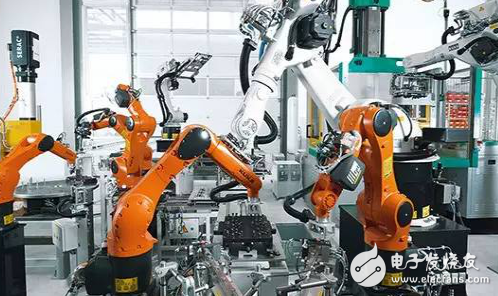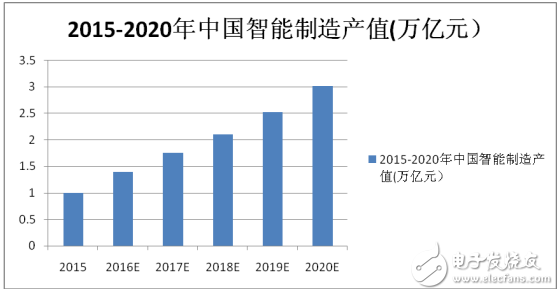China's smart manufacturing output value in 2020 or over 3 trillion yuan
After the baptism of an unprecedented global financial crisis, the world is welcoming a new wave of technological revolution and industrial transformation. Revitalizing the manufacturing industry has become a national strategy for industrial giants to compete in: the United States proposes "re-industrialization" and "manufacturing returns" to adjust and upgrade the traditional manufacturing structure and competitiveness of the country; Germany announced "to ensure the status of Germany's future industrial base - - Future Plan "Industry 4.0" Implementation Proposal, the goal is to achieve "Industry 4.0" within 8-10 years; UK publishes "British Industry 2050 Strategy"; Japan releases manufacturing white paper and new robot strategy; Korea has launched Manufacturing Innovation 3.0 strategy……
On May 8, 2015, the State Council officially released "Made in China 2025", which is the first ten-year action plan of the "three-step" strategy of China's manufacturing powerhouse.
"Made in China 2025" proposes to accelerate the integration of the next generation of information technology and manufacturing industry as the main line, to promote intelligent manufacturing as the main direction, and to build an industrial ecosystem and a new manufacturing model under the conditions of informationization.

Whether it is Germany's first "Industry 4.0" concept or China's "Made in China 2025 Plan", these all point to the same goal, that is, to promote manufacturing innovation through advanced IT and automation technology to achieve "intelligence" "to improve efficiency and reduce costs."
First, it has brought about a substantial increase in production efficiency. The first few industrial revolutions, such as steam engines, electrification liberated people's physical strength, this time is the brain power of liberating people.
Second, it brought about changes in the way of organization of production, from large-scale production to large-scale customization.
Third, the revolution in resource allocation, you can use the world's best innovation resources and manufacturing resources based on the Internet.
Fourth, bringing about changes in the way the industrial organization is organized, the platform economy, and the networking and flattening of enterprises have become new trends. Finally, new formats and new industrial forms began to emerge, such as the sharing economy and the mobile economy.
Intelligent manufacturing technology includes four levels: automation, information, internet and intelligence. The industry chain covers intelligent equipment (robots, CNC machine tools, service robots, other automation equipment), industrial Internet (machine vision, sensors, RFID, industrial Ethernet). Industrial software (ERP/MES/DCS, etc.), 3D printing, and automation system integration and production line integration that combine these links.
Industrial robots: China's industrial robot market has experienced explosive growth. By 2020, the domestic industrial robots will reach 600,000 units, and the domestic robot market will exceed 40 billion yuan. Taking into account the export factor, China is expected to produce robot companies with sales of over 10 billion.
Industrial Internet: Industrial Internet is the nerve of smart factories. Through various information collection and sensing technologies, the information in production is converted into digital signals, and the signals are transmitted to the computer system or displayed to the production personnel through wireless transmission, bus technology or industrial Ethernet technology. After data analysis and processing, implementation is carried out. More precise and efficient industrial production operations.
Industrial software: The penetration rate of domestic industrial software ERP is relatively high, while the penetration rate of control software such as MES/DCS is still quite low. According to statistics, by 2015, the market demand for industrial software will exceed 100 billion yuan, and in this market, it is still dominated by foreign software companies, and domestic manufacturers have huge space for domestic substitution.
3D printing: It is expected that the future 3D printing industry will maintain rapid growth. By 2018, global 3D printing revenue will exceed 10 billion US dollars. Domestic 3D printing is still in its infancy, and there is huge room for future development.
Intelligent manufacturing is a technical system formed by the integration of information and communication technology, electrical and electronic and micro-system technology, production technology and mechanical engineering automation, management and logistics technology. In recent years, a new generation of information technology represented by the Internet of Things, mobile Internet, big data, and cloud computing, with new manufacturing technologies represented by 3D printing, robots, and human-machine collaboration, and new energy, new materials, and biotechnology Breakthrough, cross-integration, and innovation in intelligent manufacturing technology continue to make new breakthroughs.
The "Thirteenth Five-Year Plan" period is the key period for China's manufacturing to become stronger and stronger. Intelligent transformation is the key to building and manufacturing a strong country. Realizing "digital, networked and intelligent" manufacturing is a new trend in the development of the manufacturing industry and a new round. The core of the scientific and technological revolution and industrial transformation. With the vigorous development of robots, drones, artificial intelligence, 3D printing, driverless, virtual reality, intelligent logistics, and smart home industries, the output value of China's smart manufacturing in 2015 is about 1 trillion, and the CIC Consulting Industry Research Center predicts China's smart manufacturing output value is expected to exceed 3 trillion yuan in 2020.

Figure 2015-2020 China's smart manufacturing output value (trillion yuan)
Intelligent industrial manufacturing not only increases productivity and efficiency, but also saves costs.
At present, the average level of China's manufacturing industry is not high. There are many problems such as low production efficiency and low production capacity, asymmetric information, and lack of core technology. In addition, rising labor costs and changing customer demands have caused Chinese manufacturing companies to face huge problems. The challenge.
In the face of a new wave of world scientific and technological revolutions and industrial changes, China launched “Made in China 2025†to transform and upgrade its manufacturing industry through two-in-one integration and “Internet Plus†to achieve “Made in China†and “Created in Chinaâ€. "The leap."
China and Germany are manufacturing powers and manufacturing powers respectively. The two governments are actively promoting the strategic docking between the two sides on "Made in China 2025" and "Industry 4.0". How to seize the opportunity and successfully reach the other side requires both strategic courage to face difficulties and more strategic wisdom based on reality.
“Made in China 2025†or “Industry 4.0†is a grand topic and has received extensive attention from the Chinese industry. This is a good thing, indicating that China’s industry is paying attention to a new round of scientific and technological revolution and industrial change, but needs to clearly understand China’s industrial development. At the stage, you should not blindly follow the trend, and propose to use the "Industry 4.0" to achieve industrial catch-up.
The realization of “Industry 4.0†will be a long-term process, even in Germany's most competitive factory, it is only partially implementing the “Industry 4.0†application. “Industry 4.0†is one of the ways to transform and upgrade enterprises with basic conditions, but it is not the only source of competitiveness. According to a World Bank and General Electric company forecast, "Industry 4.0" will affect 46% of the global economy.
The Chinese are widely spread, the industrial development is extremely uneven, and some are still in the industrial 2.0 era. A well-established enterprise can introduce advanced solutions or seek to overtake a corner; if the conditions are not mature, it must be based on reality and find a transformation and upgrading plan that is more in line with its own needs and more economical. We need to follow the new round of scientific and technological revolution and industrial transformation trends, based on the actual development of local and factory, and develop their own "Industry 4.0" development roadmap.
Xiaobian conclusion:
Intelligent transformation is the key to building a strong manufacturing country. In 2016, the top-level design of China's intelligent manufacturing will be further improved. The “Intelligent Manufacturing Development Plan (2016-2020)†will be prepared and released, and the “Intelligent Manufacturing Engineering†will be released and implemented. The promotion of China's intelligent manufacturing system will be officially launched, and efforts will be made to achieve manufacturing. Great powers are transforming into manufacturing powers.
Spring Clamp Terminal Block,Screwless Spring Terminal Blocks,Spring Conductor Terminal,Spring Clip Terminal Blocks
Wonke Electric CO.,Ltd. , https://www.wkdq-electric.com